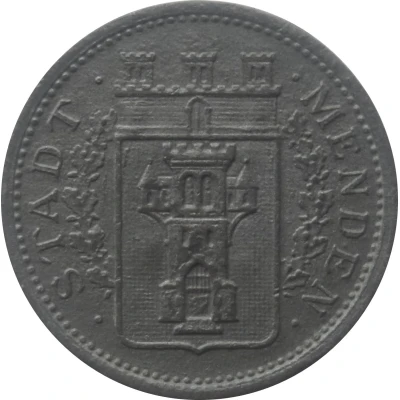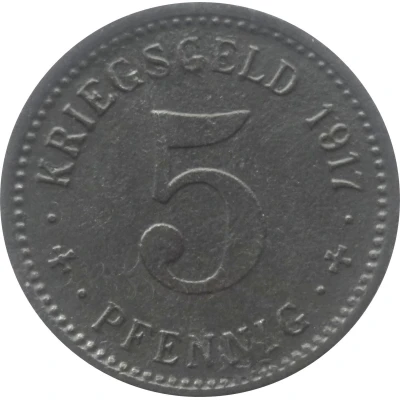


© Willem63 (CC BY-NC-SA)
5 Pfennigs - Menden
1917 year| Zinc | 1.6 g | 18.0 mm |
| Issuer | City of Menden (Prussian province of Westphalia) |
|---|---|
| Emperor | William II (Wilhelm II) (1888-1918) |
| Type | Standard circulation coin |
| Year | 1917 |
| Value | 5 Pfennigs (5 Pfennige) (0.05) |
| Currency | Mark (1914-1924) |
| Composition | Zinc |
| Weight | 1.6 g |
| Diameter | 18.0 mm |
| Thickness | 1.2 mm |
| Shape | Round |
| Technique | Milled |
| Orientation | Medal alignment ↑↑ |
| Demonetized | Yes |
| Updated | 2024-10-04 |
| Numista | N#166090 |
|---|---|
| Rarity index | 85% |
Reverse
Pearl rim, legend surrounding denomination centered
Script: Latin
Lettering:
KRIEGSGELD 1917
5
• ✠ • PFENNIG • ✠ •
Edge
Ribbed
Comment
Issuing agency: [Stadt, Westfalen].Interesting fact
The 5 Pfennigs - Menden 1917 coin was minted during a time of economic turmoil in Germany, known as the "Inflationary Period" (1914-1923). During this time, the value of the German mark (the national currency) plummeted, and prices for everyday goods skyrocketed. As a result, many Germans turned to alternative forms of currency, such as local emergency currencies like the 5 Pfennigs - Menden 1917 coin. This coin, made of zinc and weighing only 1.6 grams, was one of many emergency currencies issued by cities and towns across Germany during this time. Despite its small size and value, the 5 Pfennigs - Menden 1917 coin remains a fascinating piece of history, offering a glimpse into a unique period of economic upheaval and innovation in Germany.